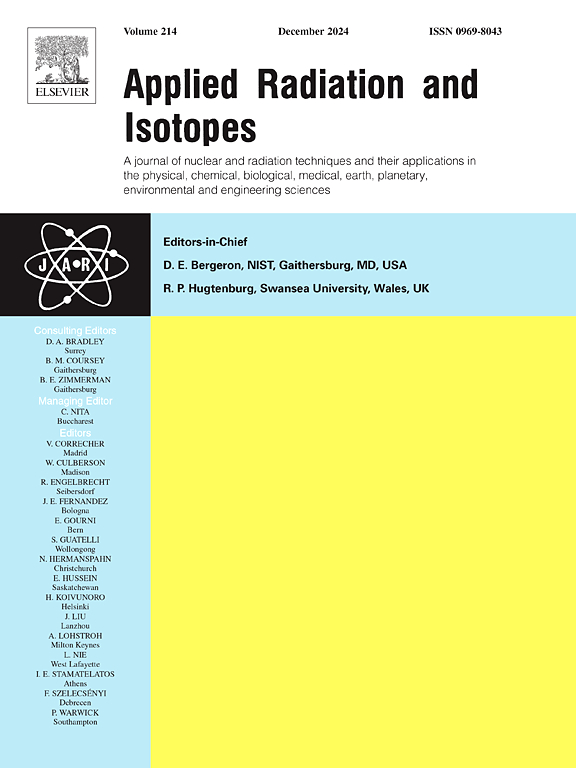Estimating patient-specific organ doses from head and abdominal CT scans via machine learning with optimized regulation strength and feature quantity
IF 1.6
3区 工程技术
Q3 CHEMISTRY, INORGANIC & NUCLEAR
引用次数: 0
Abstract
Purpose
This study aims to investigate estimation of patient-specific organ doses from CT scans via radiomics feature-based SVR models with training parameter optimization, and maximize SVR models’ predictive accuracy and robustness via fine-tuning regularization parameter and input feature quantities.
Methods
CT images from head and abdominal scans underwent processing using DeepViewer®, an auto-segmentation tool for defining regions of interest (ROIs) of their organs. Radiomics features were extracted from the CT data and ROIs. Benchmark organ doses were then calculated through Monte Carlo (MC) simulations. SVR models, utilizing these extracted radiomics features as inputs for model training, were employed to predict patient-specific organ doses from CT scans. The trained SVR models underwent optimization by adjusting parameters for the input radiomics feature quantity and regulation parameter, resulting in appropriate configurations for accurate patient-specific organ dose predictions.
Results
The C values of 5 and 10 have made the SVR models arrive at a saturation state for the head and abdominal organs. The SVR models’ MAPE and R2 strongly depend on organ types. The appropriate parameters respectively are C = 5 or 10 coupled with input feature quantities of 50 for the brain and 200 for the left eye, right eye, left lens, and right lens. the appropriate parameters would be C = 5 or 10 accompanying input feature quantities of 80 for the bowel, 50 for the left kidney, right kidney, and 100 for the liver.
Conclusions
Performance optimization of selecting appropriate combinations of input feature quantity and regulation parameters can maximize the predictive accuracy and robustness of radiomics feature-based SVR models in the realm of patient-specific organ dose predictions from CT scans.
通过优化调节强度和特征量的机器学习估计头部和腹部CT扫描的患者特异性器官剂量。
目的:研究基于放射组学特征的SVR模型在训练参数优化的情况下对CT扫描患者特异性器官剂量的估计,并通过微调正则化参数和输入特征量来最大化SVR模型的预测精度和鲁棒性。方法:使用DeepViewer®对头部和腹部CT图像进行处理,这是一种用于定义器官感兴趣区域(roi)的自动分割工具。从CT数据和roi中提取放射组学特征。然后通过蒙特卡罗(MC)模拟计算基准器官剂量。SVR模型利用这些提取的放射组学特征作为模型训练的输入,用于预测CT扫描中患者特异性器官剂量。通过调整输入的放射组学特征数量和调节参数,对训练好的SVR模型进行优化,从而得到准确的患者特异性器官剂量预测的适当配置。结果:C值为5和10时,SVR模型对头部和腹部器官达到饱和状态。SVR模型的MAPE和R2强烈依赖于器官类型。适当的参数分别为C = 5或10,再加上大脑输入特征量为50,左眼、右眼、左晶状体和右晶状体输入特征量为200。适当的参数为C = 5或10,同时输入特征量为肠80,左肾50,右肾50,肝脏100。结论:选择适当的输入特征量和调节参数组合,可以最大限度地提高基于放射组学特征的SVR模型在CT扫描患者特异性器官剂量预测领域的预测准确性和鲁棒性。
本文章由计算机程序翻译,如有差异,请以英文原文为准。
求助全文
约1分钟内获得全文
求助全文
来源期刊

Applied Radiation and Isotopes
工程技术-核科学技术
CiteScore
3.00
自引率
12.50%
发文量
406
审稿时长
13.5 months
期刊介绍:
Applied Radiation and Isotopes provides a high quality medium for the publication of substantial, original and scientific and technological papers on the development and peaceful application of nuclear, radiation and radionuclide techniques in chemistry, physics, biochemistry, biology, medicine, security, engineering and in the earth, planetary and environmental sciences, all including dosimetry. Nuclear techniques are defined in the broadest sense and both experimental and theoretical papers are welcome. They include the development and use of α- and β-particles, X-rays and γ-rays, neutrons and other nuclear particles and radiations from all sources, including radionuclides, synchrotron sources, cyclotrons and reactors and from the natural environment.
The journal aims to publish papers with significance to an international audience, containing substantial novelty and scientific impact. The Editors reserve the rights to reject, with or without external review, papers that do not meet these criteria.
Papers dealing with radiation processing, i.e., where radiation is used to bring about a biological, chemical or physical change in a material, should be directed to our sister journal Radiation Physics and Chemistry.
 求助内容:
求助内容: 应助结果提醒方式:
应助结果提醒方式:


